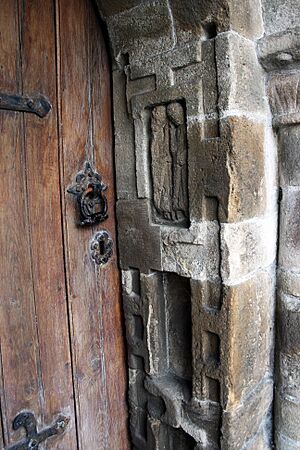St. Lachtain's Church, Freshford facts for kids
St. Lachtain's Church is a very old and special church located in the village of Freshford in County Kilkenny, Ireland. It was built in 1731, but parts of it are much, much older! The church is named after a saint called St. Lachtain, who passed away in 622. People believe that a church was first built on this spot not long after St. Lachtain died.
Long ago, when Vikings raided Ireland, St. Lachtain's Church was attacked. Its valuable gold and silver decorations were stolen, and its books were sadly burned.
The church has a beautiful old stone archway. On this arch, there is a message written in old Irish. It says something like: "A prayer for Niamh and Mathgamhan O Chearmaic, who helped build this church. And a prayer for Gille Mocholmoc O Ceannucain, who made it." This shows how important these people were to the church's history.
Contents
History of St. Lachtain's Church
Early Beginnings and Rebuilding
The church you see today has a long history. The first church on this site was likely built in the 600s. Then, in the year 1100, St. Lachtain's Church was rebuilt. The amazing stone porch and doorway you can still see today are the only parts left from that 1100 building. This style of building is called Hiberno-Romanesque, which means it mixes Irish and Roman building ideas.
Freshford's Church Importance
During St. Lachtain's time, Freshford was an important religious center, like a main area for a bishop. By 1225, a special house for the bishop was built nearby in a place called Uppercourt. This house was used as a summer home for over 300 years! The rest of the church building that stands now was built in 1731 for the Church of Ireland.
Protecting the Ancient Doorway
In the 1800s, gates were put in front of the main entrance of the church. This was done to stop local people from sharpening their knives on the old stone doorway. It helped protect the ancient and beautiful carvings.
A National Treasure
The old sandstone Romanesque doorway of St. Lachtain's Church is very important. It is considered a National Monument in Ireland. This means it is a protected historical site that is very special to the country's heritage.


